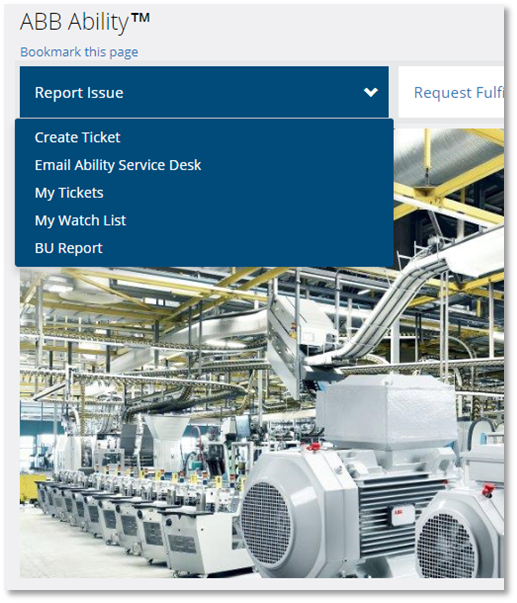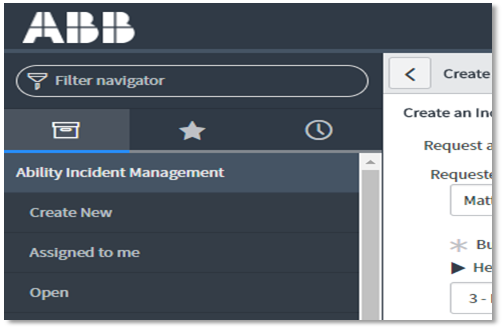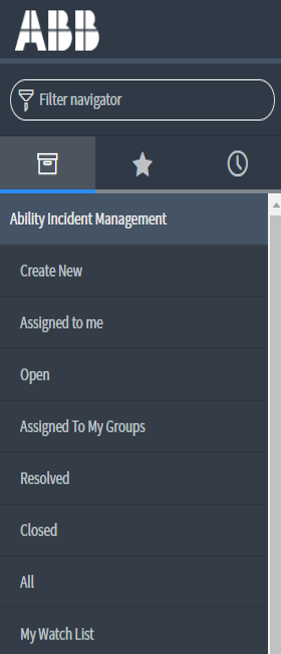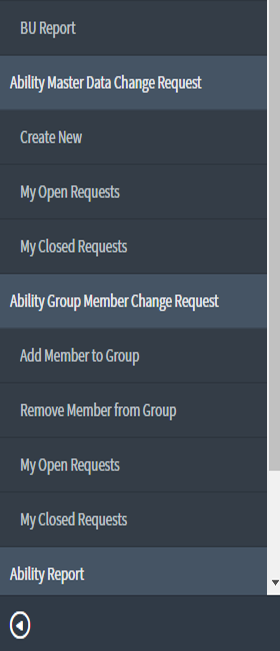# Ticket Tool Support
INTERNAL PROCESS
All steps listed below this break are internal steps taken by the ABB Ability™ Platform Operations team. These are listed for transparency purposes.
After reviewing this course, you should have a solid understanding of the support analyst workflow. You should also know how to utilize the ServiceNow incident management portal to resolve and close tickets.
This tutorial provides instruction and insight into using the ABB Ability™ Platform Ticketing system as a support analyst.
Support analyst levels of responsibilities:
| Role | Responsibilities |
|---|---|
| L3 - Service Desk Analyst | • Provides initial diagnosis of incident |
| • Offers initial support to the submitter of the incident | |
| • Assigns ticket to appropriate Resolver Group if ticket can't be immediately resolved | |
| • Obtains further clarification from the submitter of the incident if more information is needed | |
| Operations Manager | • Ensures that tickets are responded to in an appropriate time frame |
| • Takes ownership of tickets considered major incidents and tracks them to closure | |
| L4 - Resolver Group Analyst | • Provides diagnosis of incidents |
| • Reassigns incidents if the ticket is originally assigned to the incorrect Resolver Group | |
| • Communicates to original Service Desk Analyst if an incident was not assigned to the correct Resolver Group | |
| • Obtains further clarification from the submitter of the incident if more information is needed |
The high-Level incident management process contains the following steps as performed by a support analyst:
| Steps | Persons Involved |
|---|---|
| 1. Identification & Logging | Service Desk Analyst, Business Unit |
| 2. Categorization, Prioritization, & Classification | Service Desk Analyst |
| 3. Initial Diagnosis | Service Desk Analyst |
| 4. Investigation & Diagnosis | Service Desk Analyst, Resolver Group Analyst |
| 5. Resolution | Service Desk Analyst, Resolver Group Analyst |
| 6. Closure | Service Desk Analyst, Resolver Group Analyst |
A detailed discussion of the steps outlined above follows.
# Identification and Logging
Incidents will be raised by BLs through one of the following ways:
- By submitting a ticket through the ServiceNow "Create Ticket" function. This is the recommended process for submitting a ticket.
- By sending an email to abb-ability-helpdesk@abb.com.
- A ticket may be submitted on behalf of a BL by a support analyst through the internal portal.


# Initial Diagnosis
The process for this step begins with the L3 Service Desk assessing if the incident can be resolved at their level. If L3 is unable to resolve the incident, they must assign it to the appropriate resolver group. The Service Desk group has a list of available Resolver Groups they are able to assign incidents to.
Following is a table of service desk groups and managers.
| ID | Description | Manager | Zone |
|---|---|---|---|
| Ability-ServiceDesk-L3 | L3 Ability Service Desk Team | Marc Leroux | |
| marc.leroux@us.abb.com | India Ability-CSA-L4 | L4 Ability Cyber Security Support | |
| Team | Bart de. Wijs bart.dewijs@nl.abb.com | India Ability-CST-L4 | L4 Ability |
| Client Success Support Team | Marc Leroux marc.leroux@us.abb.com | Poland | |
| Ability-Product-Cloud-L4 | L4 Ability Product Cloud Support Team | Ronnie Pettersson | |
| ronnie.pettersson@us.abb.com | Poland Ability-Product-Edge-L4 | L4 Ability Product | |
| Edge Support Team | Ronnie Pettersson ronnie.pettersson@us.abb.com | USA | |
| Ability-QA-L4 | L4 Ability QA Support | Xiaomei Zheng | |
| xiaomei.zheng@fi.abb.com | India Ability-CPM-L4 | L4 Ability CPM Support Team | Mika |
| Luotojarvi mika.luotojarvi@fi.abb.com | Finland |
# Investigation and Diagnosis
The Service Desk or the Resolver Group provides the initial support to the user. The Service Desk Analyst will assign the incident to the appropriate Resolver Group. When the incident is assigned to the Resolver Group, the Resolver Group analyst should confirm if the incident has been assigned correctly and reassign the ticket to the correct Resolver Group if incorrectly assigned. The Service Desk Analyst of the Resolver Group will get further clarification from the user as needed. The analyst should set the ticket to "Awaiting User Info" status if this is the case.
| Role | Responsibilities |
|---|---|
| L3 - Service Desk Analyst | • Provides initial diagnosis of incident |
| • Offers initial support to the submitter of the incident | |
| • Assigns ticket to appropriate Resolver Group if ticket can't be immediately resolved | |
| • Obtains further clarification from the submitter of the incident if more information is needed | |
| Service Desk Manager | • Ensures that tickets are responded to in an appropriate timeframe |
| • Takes ownership of tickets considered major incidents and tracks them to closure | |
| L4 - Resolver Group Analyst | • Provides diagnosis of incidents |
| • Reassigns incidents if the ticket is originally assigned to the incorrect Resolver Group | |
| • Communicates to original Service Desk Analyst if an incident was not assigned to the correct Resolver Group | |
| • Obtains further clarification from the submitter of the incident if more information is needed |
# Resolution
The Resolver Group or the Service Desk Analyst involved in incident handling will investigate and diagnose the incident. Further resolution steps are explored if needed. The resolution steps taken by the resolver group or service desk analyst are updated in the incident work log.
While investigating and analyzing the incident, the analyst will consider the following points:
Establish exactly what has gone wrong
Identify the cause of the incident
Establish the chronology of the events
Identify the impact of the incident, including the number and range of users affected across locations
Identify any events that could have been the trigger for the incident
# Closure
Once the status of the incident is set to "Resolve" in Service Desk, an auto-generated email is triggered to the user to check if the user is satisfied with the incident resolution. If the user confirms that the resolution provided is satisfactory to him/her, then the incident is considered as "Closed", and is left for auto-closure. The Service Desk Analyst and the Resolver Group analyst will update the Ticket with the details of the resolution provided and steps taken to resolve the incident. Once an incident status is set to "Resolved," an email is sent to the ticket submitter. The submitter has the option to immediately close the ticket or reopen for review. A ticket will automatically close after 14 days once in a "Resolved" state.
Every incident will have the following details updated in the ticket workflow:
Closure categorization
Complete incident resolution information
# ServiceNow Walkthrough
Following is the Navigation Panel for accessing Incident Management options.


